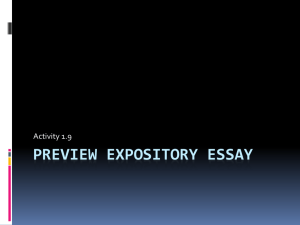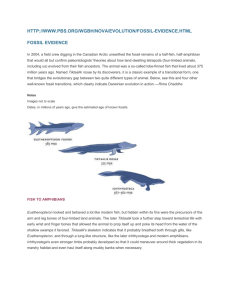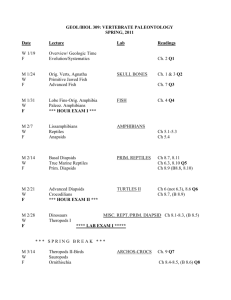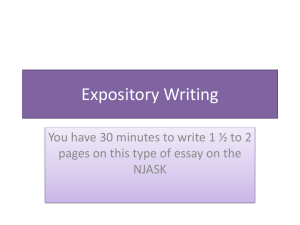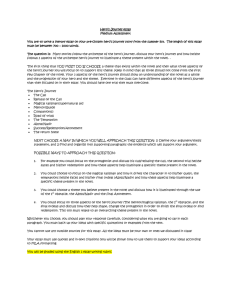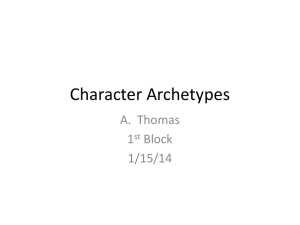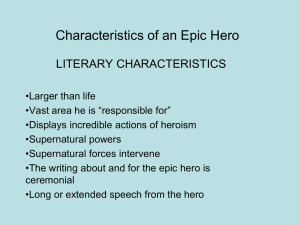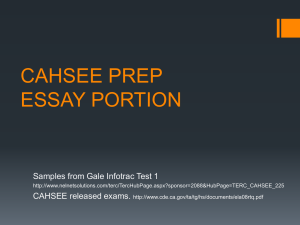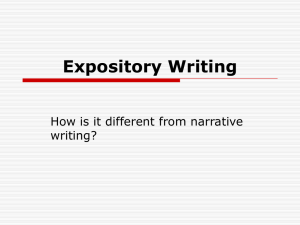Do Now - Renton School District
advertisement
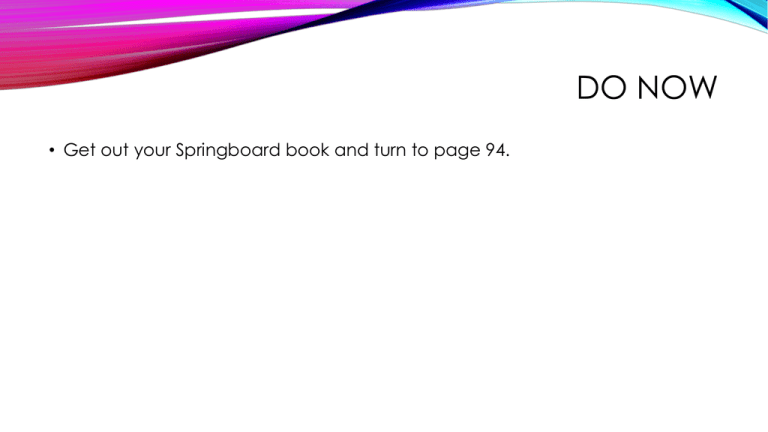
DO NOW • Get out your Springboard book and turn to page 94. LEARNING TARGETS/OBJECTIVES • IWBAT analyze how a writer uses the compare and contrast structure to communicate ideas. • IWBAT explain UNPACKING EA1 What do students need to know/be able to do? • Ideas about the book: • Utopia, dystopia, Hero’s Journey • Characterization, change + compare to another character • Analyze how conflict leads to character changes, which reveals the theme (apply Hero’s Journey) • Expository Writing Structure: • Introduction, body paragraphs, conclusion, transitions • Compare/contrast structure • Appropriate voice, active voice, literary terms, precise language • Using strongest evidence-TQLC FAHRENHEIT WRITING PROMPTS (YOU WILL CHOOSE ONE!) • Prompt 1: Think about the protagonist’s characteristics, what he achieved, and how he changed by the end of the story. Contrast the protagonist with another character from his society. • Prompt 2: Think about the final stage in the Hero’s Journey: the Crossing, or Return Threshold. What does the hero learn about life as a result of the Journey (theme)? • Prompt 3: Write an essay that explains how the protagonist (hero) changes as a result of conflict with his dystopian society (Road of Trials), and explain how this change connects to the novel’s theme (the Crossing, or Return Threshold). EXPOSITORY WRITING • Expository writing: writing to explain or define a concept or idea. • There are many types of expository writing: • Cause-and-Effect Essays • Newspaper articles • Magazine articles • Compare and contrast essays- a rhetorical strategy and method of organization where the writer examines the similarities and differences between two people, places, ideas and things. HOW TO ORGANIZE YOUR OWN COMPARE AND CONTRAST WRITING • Before you write an essay, you should always have some sort of a pre-write. • The examples below shows 2 ways a writer could choose to organize their writing. They are comparing and contrasting reptiles to mammals. Subject by Subject Organization Feature by feature organization Discuss all the feature of one subject and then all the features from the other subject. Select a feature common to both subjects and then discuss each subject’s feature. Then go on to the next. Subject A: Mammals - Feature 1: Habitat - Feature 2: Reproduction - Feature 3: Physiology Subject B: Reptiles - Feature 1: Habitat - Feature 2: Reproduction - Feature 3: Physiology Feature 1: Habitat - Subject A: Mammals - Subject B: Reptiles Feature 2: Reproduction - Subject A: Mammals - Subject B: Reptiles Feature 3: Physiology - Subject A: Mammals - Subject B: Reptiles • What are the differences between the 2 structures? • Why would an author choose one over the other? WHAT GRAPHIC ORGANIZERS COULD YOU USE? • What graphic organizers could we use to help us brainstorm and generate ideas for a compare and contrast essay? • Make mini-versions of the organizers in your notes! READING A COMPARE AND CONTRAST READING • Last quarter we studied poems and informational pieces about Abraham Lincoln and Frederick Douglass. • Today we are going to read a text that compares and contrasts Ulysses S. Grant, the general of the Union Army and Robert E Lee the general of the Confederate Army. HEROIC ATTRIBUTES Ulysses S. Grant, Leader of the Union Army • “Although a soldier by profession, I have never felt any sort of fondness for war, and I have never advocated it, except as a means of peace.” Robert E. Lee, Leader of the Confederate Army • “Duty is the most sublime word in our language. Do your duty in all things. You cannot do more. You should never wish to do less.” READ BY YOURSELF, THEN WITH YOUR PARTNER On the SECOND READ: • Annotate the text by marking the similarities and differences in each paragraph. • Highlight the features you see the author comparing and contrasting through out the piece. AFTER READING • Skim back over your annotations and make a general outline of the text’s organizational structure. • Start with Paragraphs 1-3: Introduction to both men • What is the central idea of the text? Include evidence and reasoning/analysis in your answer. FORMATIVE ASSESSMENT • Write a short compare and contrast ESSAY comparing Robert E. Lee and Ulysses S. Grant. • Be sure to: • Explain at least one difference and one similarity on the two subjects. • Organize your ideas logically by using one of the organizational strategies in your notes. • Use TLQC: transition, lead-in, quote and citation You have two days to do this. It is a formative assessment, not a summative!
